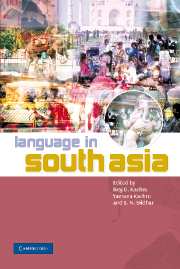Book contents
- Frontmatter
- Contents
- List of Figures
- List of Maps
- List of Tables
- Preface
- Acknowledgments
- List of Abbreviations
- Note on Transcription
- Introduction: languages, contexts, and constructs
- Part 1 Language history, families, and typology
- Part 2 Languages and their functions
- Part 3 Sanskrit and traditions of language study
- Part 4 Multilingualism, contact, and convergence
- Part 5 Orality, literacy, and writing systems
- Part 6 Language conflicts
- Part 7 Language and modernization
- Part 8 Language and discourse
- Part 9 Language and identity
- Part 10 Languages in diaspora
- 25 South Asian languages in the second diaspora
- 26 South Asian diaspora in Europe and the United States
- References
- Subject Index
- Language Index
- Author Index
26 - South Asian diaspora in Europe and the United States
Published online by Cambridge University Press: 04 May 2010
- Frontmatter
- Contents
- List of Figures
- List of Maps
- List of Tables
- Preface
- Acknowledgments
- List of Abbreviations
- Note on Transcription
- Introduction: languages, contexts, and constructs
- Part 1 Language history, families, and typology
- Part 2 Languages and their functions
- Part 3 Sanskrit and traditions of language study
- Part 4 Multilingualism, contact, and convergence
- Part 5 Orality, literacy, and writing systems
- Part 6 Language conflicts
- Part 7 Language and modernization
- Part 8 Language and discourse
- Part 9 Language and identity
- Part 10 Languages in diaspora
- 25 South Asian languages in the second diaspora
- 26 South Asian diaspora in Europe and the United States
- References
- Subject Index
- Language Index
- Author Index
Summary
Introduction
The third diaspora of Asian Indians (see Chapter 25) involves migration to the United States, United Kingdom, Canada, and Australia, to mention just a few countries. This chapter concentrates on South Asian diaspora in the United Kingdom and United States. Detailed studies of South Asian languages in diaspora, as discussed in Chapter 25 are nonexistent for Asian Indian communities in these countries, except for some data on language use in select Asian Indian linguistic communities in the United States that this author has collected over the years. What we have is attitudinal surveys that discuss the users and uses of South Asian languages, primarily in the United States and United Kingdom. Two brief profiles of South Asian diasporic communities are presented here with special emphasis on the efforts being made to maintain the languages and cultures by the various ethnic groups.
The term “South Asian” needs some clarification, especially with reference to how these communities are identified in the censuses of these two countries:
In the United Kingdom, most of the earlier immigrants (from British India) were identified as “Overseas Indians.” Finer distinctions between South Asian communities did not start until 1947 when, after the formation of Pakistan, Pakistanis were identified as a distinct group. What was earlier East Pakistan became Bangladesh in 1971, and the Bangladeshis were listed in subsequent census reports (Mishra and Mohapatra 2001: i).
[…]
- Type
- Chapter
- Information
- Language in South Asia , pp. 515 - 533Publisher: Cambridge University PressPrint publication year: 2008
- 4
- Cited by



